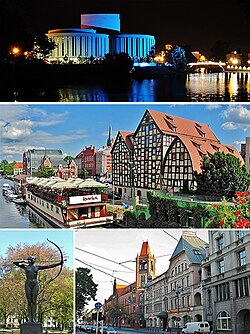Bydgoszcz
Bydgoszcz [ˈbɨdɡɔʂt͡ʂ] (![]() listen) (German: Bromberg, Latin: Bydgostia) is a city in the north of Poland, capital of Kujavia-Pomerania voivodship, on the Brda and Wisła rivers. As of 2020, 345 000 people live there.[1] Bydgoszcz is one of the biggest cities in Poland - placed in the 8th position. The city was started in 1346 by the king of Poland Casimir III the Great. Patrons of the city are Saint Martin of Tours and Saint Nicholas.
listen) (German: Bromberg, Latin: Bydgostia) is a city in the north of Poland, capital of Kujavia-Pomerania voivodship, on the Brda and Wisła rivers. As of 2020, 345 000 people live there.[1] Bydgoszcz is one of the biggest cities in Poland - placed in the 8th position. The city was started in 1346 by the king of Poland Casimir III the Great. Patrons of the city are Saint Martin of Tours and Saint Nicholas.
Bydgoszcz | |
|---|---|
 Top: Opera Nova Middle: The Brda River and the town granaries Bottom: Statue of 'The Archeress', Jagiellońska Street. | |
| Coordinates: 53°7′N 18°0′E / 53.117°N 18.000°E | |
| Country | Poland |
| Voivodeship | Kuyavian-Pomeranian |
| Established | before 1238 |
| Town rights | 1346 |
| Government | |
| • President (Mayor) | Rafał Bruski (PO) |
| • City Council Chairperson | Roman Jasiakiewicz (PO) |
| Area | |
| • City | 174.57 km2 (67.40 sq mi) |
| Elevation | 60 m (200 ft) |
| Population (2011) | |
| • City | 363,926 |
| • Density | 2,100/km2 (5,400/sq mi) |
| • Metro | 470,285 |
| Time zone | UTC+1 (CET) |
| • Summer (DST) | UTC+2 (CEST) |
| Postal code | 85-001 to 85-950 |
| Area code | +48 52 |
| Car plates | CB |
| Website | www |
The city is a big center of industry, trade, logistic and traffic cord. In the city is located the Ignacy Jan Paderewski International Airport. In Bydgoszcz, there's a big military garrison and headquarters of most NATO institutions present in Poland.
Tourism
changeBydgoszcz belongs to the greenest cities in Poland, has more than 30 parks which occupy more than 970 hectares. In the north part of the city, the biggest city park in Poland - Myślęcinek - is located.
Bydgoszcz has many monuments, starting with the gothic cathedral and ending with the downtown, which has Art Nouveau tenement houses. A unique monument is the oldest in Poland artificial waterway - Bydgoszcz Canal, which connects the Vistula and the Oder rivers.
The most visited place in Bydgoszcz is Old Town with the Mill Island. The most important monuments in this area are gothic churches, including a cathedral, fragments of city walls and granaries from the XVII century.
Bydgoszczy's downtown was built almost completely between 1850 and 1914 and is famous for Art Nouveau tenement houses. The east part of the downtown was built on assumptions garden city movement. The Music District - with the Pomeranian Filharmonija, the Bydgoszcz Academy of Music and the Polish Theatre are also located here.
Bydgoszcz has many museums. The biggest one is the Leon Wyczółkowski Regional Museum which has a wide collection including art, numismatics, archeology and souvenirs related to Bydgoszcz.
Gallery
change-
Saints Martin and Nicholas cathedral
-
Leon Wyczółkowski Regional Museum
-
Opera Nova
-
Mill Island
-
Bydgoszcz Venice
-
Exploseum in Bydgoszcz
References
change- ↑ "Baza Demografia - Główny Urząd Statystyczny". demografia.stat.gov.pl. Retrieved 2021-03-26.


